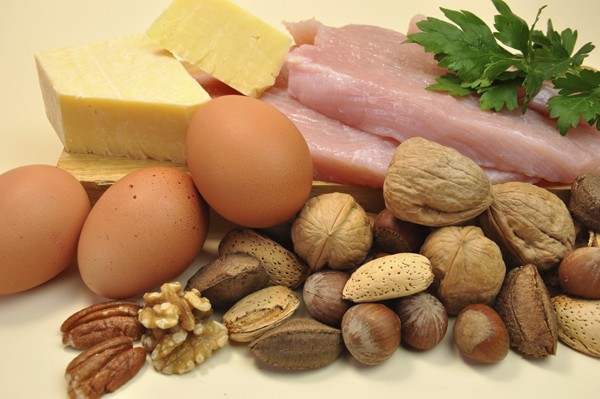Protein is vital for overall health, playing a crucial role in building and repairing tissues, producing enzymes and hormones, and supporting the immune system. While often associated with athletes and bodybuilders, adequate protein intake is essential for everyone, especially women. But how much protein for women is truly optimal? Let’s delve into the science-backed recommendations and factors influencing individual protein needs.
Understanding Protein Requirements
The Recommended Dietary Allowance (RDA) for protein is 0.8 grams per kilogram of body weight, or 0.36 grams per pound. This number represents the minimum amount needed to prevent deficiency, not necessarily the ideal amount for optimal health.
To calculate your daily protein intake based on the RDA, simply multiply your weight in pounds by 0.36. Keep in mind that this is a baseline, and several factors can influence your individual needs.
Protein Needs for Women: A Closer Look
 photo of an assortment of high-protein foods including cheese, eggs, fish, nuts
photo of an assortment of high-protein foods including cheese, eggs, fish, nuts
An array of protein-rich food sources including dairy, eggs, seafood and nuts.
For example, a sedentary 50-year-old woman weighing 140 pounds would need approximately 53 grams of protein per day to meet the RDA. However, this number can vary significantly based on activity level, age, and physiological state.
Pregnancy and Lactation
During pregnancy, a woman’s protein needs increase substantially to support fetal development and the growth of maternal tissues like the placenta and breasts. Experts often recommend 75 to 100 grams of protein per day during pregnancy. Breastfeeding women also require increased protein intake to support milk production. Consult with your doctor or a registered dietitian to determine your specific protein needs during these periods.
Activity Level
Active women, especially those engaging in regular exercise, require more protein to repair and rebuild muscle tissue. The more intense and frequent the activity, the greater the protein requirement. While the RDA may suffice for sedentary individuals, active women may benefit from consuming 1.2 to 2.0 grams of protein per kilogram of body weight (0.54 to 0.9 grams per pound) depending on the intensity and type of exercise.
Age
As we age, we naturally lose muscle mass, a process known as sarcopenia. Adequate protein intake becomes even more critical to preserve muscle mass and strength in older adults. Older women may benefit from consuming 1.0 to 1.2 grams of protein per kilogram of body weight (0.45 to 0.54 grams per pound) to combat age-related muscle loss.
Beyond the Numbers: The “Protein Package”
While focusing on the quantity of protein is important, it’s equally crucial to consider the “protein package” – the other nutrients that come along with your protein sources.
Instead of solely focusing on hitting a specific number, consider the overall quality of your diet and choose protein sources that are also rich in essential nutrients and low in unhealthy fats and processed ingredients.
Prioritize Healthy Protein Sources
Opt for lean protein sources such as:
- Fish and Seafood: Tuna, salmon, haddock, trout
- Poultry: Chicken, turkey
- Dairy: Greek yogurt, cottage cheese, milk
- Legumes: Beans, lentils
- Nuts and Seeds: Almonds, walnuts, chia seeds, flax seeds
- Eggs
Limit your intake of processed meats and red meat, which can be high in saturated fat and other potentially harmful compounds.
Distributing Protein Intake Throughout the Day
Emerging research suggests that spreading protein intake evenly throughout the day may be more effective for muscle protein synthesis than consuming the majority of your protein in one or two large meals. Aim to include a source of protein in each meal and snack to optimize muscle growth and repair.
Potential Benefits of Higher Protein Intake
While more research is needed, some studies suggest that a higher protein intake may offer several benefits, including:
- Weight Management: Protein can increase satiety, helping you feel fuller for longer and potentially reducing overall calorie intake.
- Muscle Preservation: Adequate protein intake is crucial for preserving muscle mass, especially during weight loss or aging.
- Improved Blood Sugar Control: Protein can help stabilize blood sugar levels, which is particularly beneficial for individuals with diabetes or insulin resistance.
Considerations and Potential Risks
While protein is essential, excessive intake can have potential risks. Some studies suggest that very high protein diets may put a strain on the kidneys. However, this is more likely to be a concern for individuals with pre-existing kidney problems.
It’s always a good idea to consult with a healthcare professional or registered dietitian before making significant changes to your diet, especially if you have any underlying health conditions.
Conclusion
Determining how much protein for women is optimal depends on individual factors like activity level, age, and physiological state. While the RDA provides a baseline, active women, pregnant or breastfeeding women, and older adults may benefit from consuming more protein. Focus on incorporating healthy protein sources into your diet and distributing your intake throughout the day to optimize muscle health and overall well-being. Remember to consider the “protein package” and prioritize nutrient-rich foods over processed options. By understanding your individual needs and making informed choices, you can ensure you’re getting the right amount of protein to thrive.
